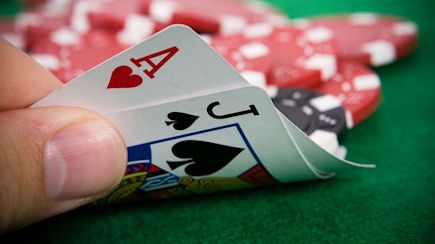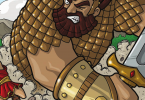This article first appeared in the Jul/Aug 2010 issue of World Gaming magazine.
One of the more obscure rules of blackjack is that of surrender. Many players don’t even know that it exists, and most of those that do know it exists don’t know when they should surrender. Our resident blackjack experts Andrew Scott and Harry-Lee Dong Wu take a look at when to cry “uncle!”
Surrender has been a feature of Macau blackjack for decades, and is part of what makes Macau blackjack so special. Macau style surrender is what blackjack experts call ‘early surrender not against ace’. What does this mean? And how can immediately choosing to lose half your bet cause you to actually win more?
The term ‘surrender’ refers to completely giving up on your hand after you have received your first two cards. You tell the dealer you surrender (by making a hand signal like drawing a line below your bet) and the dealer will take half your chips bet, returning the other half to you. The hand is now over for you. There are some games with half win (not half loss) styles of surrender (usually if you have got five cards totaling 21 or less) but they are very rare. The advantage of surrender is that you only lose half your bet (as opposed to all of your bet) but the disadvantage is that the loss is certain. If you hadn’t surrendered and had gone on to play the hand to its natural conclusion you might have got a push (also known as a standoff) or even won!

Of course you will only consider surrender when the first two cards you receive are bad. In fact, you should only consider surrender when the first two cards you receive are bad and the dealer has a strong upcard (the dealer’s upcard is his first faceup card). Surrender is only suitable in very grim situations. Thinking of it like chopping off a leg to save your life – the lesser of two evils!
The surrender rules around the world have differences in style. One of those differences is between so-called ‘early surrender’ and so-called ‘late surrender’. With late surrender, you can’t surrender against a dealer blackjack. This is normally done in games where the dealer receives two cards during the initial deal (a face-up ‘upcard’ and a face-down ‘hole card’) and the surrender option is offered to the players after the dealer has determined whether he has blackjack or not. Late surrender is rarely offered in ‘no hole card’ blackjack games.
Here in Macau we have ‘early surrender’. Early surrender is a great rule that adds massive value to the game for the players, if offered without limitation. This happened in 1979 when casino gaming first started in the state of New Jersey in the US. Resorts casino in Atlantic City was the first casino to open in New Jersey and they offered a completely unlimited early surrender option, but it was simply too favourable to the players and Resorts was later forced to withdraw it. Unlimited early surrender is generally not sustainable for a casino unless the other rules in that casino’s blackjack game are particularly bad.
Here in Macau the early surrender is a sustainable option because it is limited in that the player is not permitted to surrender against the dealer ace upcards. About 62 percent of early surrender’s value comes from the surrenders you make against the dealer aces.
Here’s a fundamental truth of blackjack: every hand, no matter how bad, can win – and very hand, no matter how good, can lose (or maybe push).
So when thinking about your hands, you need to know how it will fare in the long run if played out thousands, even millions, of times. As we have explained before you can measure this by a concept known as the long run expectation of the hand. Think of the LRE as a ‘score’ for the value of that hand. The LRE is a percentage, and can be positive (winning) or negative (losing).
When you surrender, you lose half your bet. Therefore, if a two card starting hand has a LRE worse than minus 50 percent, it should be surrendered. Minus 50 percent is a pretty bad score. Excluding hands against the dealer ace (because we can’t surrender in those situations), only the six very worst hands have it. We call them the ‘Surrender Six’. You can see the ‘Surrender Six’ in the table below.
|
The Surrender Six
|
|
|---|---|
|
Your first two cards
|
Dealers upcard
|
|
14 (T4, 95 or 86)
|
10
|
|
15 (T5, 96 or 87)
|
10
|
|
16 (T6 or 97)
|
10
|
|
16 (T6 or 97)
|
9
|
|
Pair of 7s
|
10
|
|
Pair of 8s
|
10
|
So there you have it, they are the six situations where you should surrender in Macau. Notice that five of the six are against the dealer’s ten upcard. The only non-ten upcard you surrender is your hand of sixteen (T6 or 97) against the dealer’s 9. Also note that you never surrender when you have a soft total. You might be tempted to surrender a 15 against a 9 or a 13 against a 10, but in the long run you’d be wrong to do it. I have seen these kinds of incorrect surrender plays numerous times in Macau, and these players are just costing themselves money.
The ‘Surrender Six’ decisions will occur almost exactly seven percent of the time. So 93 percent of the time you aren’t surrendering, you play on with your hand (standing, hitting, doubling or splitting).
It’s interesting to note that if you could early surrender against the dealer’s ace, you would be doing it a lot, specifically with these hands: 5, 6, 7, 12, 13, 14, 15, 16, 17 and a pair of 3s, 6s, 7s and 8s. While that is a lot of hands, they only come up 3.8 percent of the time. This is because a dealer’s ace upcard is much rarer than the dealer’s ten upcard – for every one time the dealer has an ace upcard he has a ten upcard four times.
Thanks for wading through this quite technical article on surrender! If you forget all the explanations and just remember to surrender only with the surrender six and no other hands, we guarantee your bottom line on blackjack will definitely be healthier.







